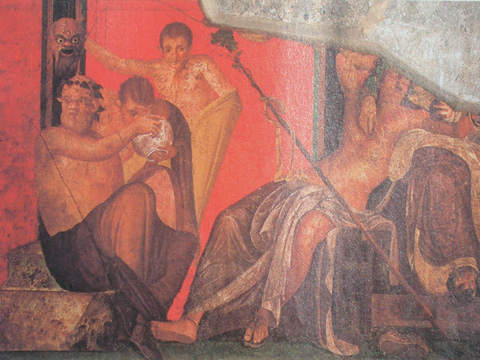
Wine has been enjoyed by various civilizations for thousands of years, primarily in the Mediterranean region. Grapevines, along with olives and figs, became the first wild fruits to be cultivated by man and there is conclusive evidence of grapevine plantations existing from the 4th millennium BC in both Egypt and Mesopotamia.
During the age of the Pharaohs, knowledge of viticulture and wine making greatly expanded and many methods--especially in relation to the pressing of the grapes--remained unchanged for thousands of years. The fertile banks of the Nile also fostered the development of the wine trade with the advent of ships and caravans delivering their liquid cargo to the trading centres of the Mediterranean.
This trade, in turn, led to the establishment of vines throughout ancient Greece around the 2nd millennium BC. Greek wine eventually achieved such a reputation that the Romans, centuries later, regarded Greek grape varieties as synonymous with premium wines. Incidentally, the origin of the word 'wine' can be traced back to the Greek 'oinos' or 'woinos', later lending itself to the Latin 'vinum'.


| ▲ |
By the first half of the 1st millennium BC, the Greeks had introduced viticulture to the south of France, Sicily and southern Italy, the latter of which rose to the status of 'ointria' or 'wine land'. This designation became 'Enotria' under the Romans who began planting vineyards throughout Italy as early as the 3rd century BC. After the most important center of wine trade in all of Italy, Pompeii, was destroyed by the eruption of Mt Vesuvius in 79 AD, efforts to develop viticulture throughout the Empire increased dramatically. Due to Vesuvius' destruction, the entire cultivatable land in the Roman heartland (modern day Lazio) was stocked with vines, prompting the Emperor Domitan to issue an edict banning the planting of any further vineyards (when was edict issued?).
This edict remained in force for almost 200 years until Marcus Aurelius Probus lifted the ban to ensure that his troops in the northern and eastern provinces would be well-supplied with wine. This led to extensive viticulture development along the Mosel and Danube rivers, paving the way for the modern vine growing regions of Germany and Austria. Indeed, the Romans planted large areas with vines almost everywhere they went, spreading their extensive knowledge of winemaking and its associated tools, including the grape press, amphora and the wooden barrel.
| ▲ |
The decline of the Roman Empire brought stagnation to almost all of Europe's wine producing regions and it wasn't until the 7th and 8th centuries that conditions improved, first in Gemany and France and later in Italy and Spain. The wine trade in Italy didn't really begin to revive until the 12th and 13th centuries after the development of the coastal trading cities of Genoa and Venice, which profited from the Crusades. The rise of Florence as a European capital of finance also helped fuel Italy's wine renaissance.
By utilizing their extensive financial contacts and experience, wealthy families such as the Antinoris and Frescobaldis made wine a highly profitable business again, trading throughout Europe and England.
In France and Germany it was primarily Charlemange who, in the course of consolidating Western Europe, actively initiated the revival of viticulture. However the actual protagonists of winemaking were the monks of Cistercian and Benedictine medieval monasteries, particularly in the Burgundy and Bordeaux regions of France and Rheingau in Germany. These monks laid the foundation for the high status of these regions' products today. Wine became France's most important export during this period and Germany itself was covered with three times more vineyards than today (750,000 acres or 300,000 ha?). The Cistercian monastry at Eberbach in the Rheingau became, during the 12th and 13th centuries, Europe's largest wine producer (out of monasteries or just in general?) with almost 200 trading outlets across the entire continent.
Around the same time the Spanish wine industry was re-emerging, albeit at a much slower pace. Following the Christian reconquest of the country, effectively ending centuries of Moorish rule, Spanish sweet wine became extremely popular throughout Europe, especially in England where it was favored by the royal court.
Spain's ambitions of world power during the 15th and 16th centuries also resulted in the introduction of European viticulture to the recently discovered New World, first in Mexico and later in what is now Chile.
Despite England's seeming lack of renown in the wine arena, the country would eventually emerge to develop the wine trade into a truly global enterprise.
Some popular grape varieties and tasting notes:
1. Cabernet Sauvignon
Probably the most popular and widespread red wine grape variety, flourishes in warm climates such as California, Australia, Chile, Italy and Spain. A New World staple. Typical aromas/flavours include blackcurrants, cherry, black pepper.
Ambrosia Recommendation: Privada Cabernet Sauvignon, Chile.
2.Shiraz/Syrah
Originally from northern Rhone, France, this grape variety creates powerful, complex red wines. Popular in Europe for centuries, it has gained rapid ground amongst New World wine producers, especially those in Australia. Typical aromas/flavours include wild berries, liquorice, black pepper and chocolate.
Ambrosia Recommendation: McGuigan Black Label Shiraz, Australia.
3.Zinfandel
A lesser known grape variety. Although capable of producing powerful dry reds it is often made into light, easy-drinking variations such as rose, especially in California. In this form typical aromas/flavours include redcurrants, watermelon and cherries.
Ambrosia Recommendation: Turning Leaf White Zinfandel, California.

